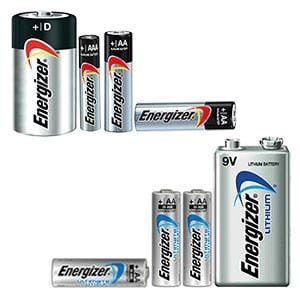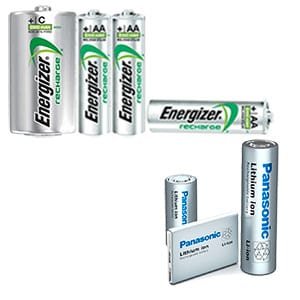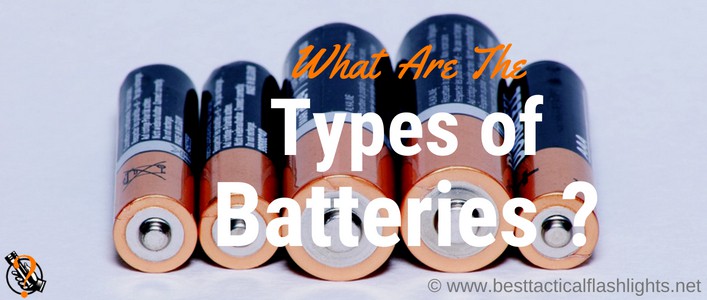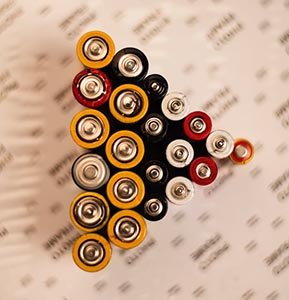Have you ever wondered just how many different battery types there were? Do you ever wonder what types of batteries work best with what devices? If you answered yes to either of these questions we have good news for you. Although we don’t go over every battery type available, this article talks about some of the most common battery types. Keep reading to find out what those are and what batteries work best in what applications.
What Types of Batteries Are There?
Storing power has been something that society has been trying to do for a long time. We have this article about the history of batteries if you want to learn more. No matter how advanced technology becomes it has not been able to solve the fact that different devices need different types of batteries. There is no one battery that can power every device. There are many different battery types currently used to power various devices, but they can be grouped into only two main categories: primary and secondary.
Primary batteries are often referred to as disposable, single-use, or even throw away batteries as they cannot be recharged once they have been used up. One of the greatest things about primary batteries is they can be used directly out of the package. They provide a current as soon as they are put into the appropriate device. Primary batteries are intended to be thrown away after a single use. They are used to provide portable power to devices that need a low current drain or in devices that are only used on occasion. Primary batteries make a great choice for devices that have no other power source available, such as a communication circuit where power is available intermittently.
Secondary batteries are rechargeable batteries as they can be recharged multiple times so they can be reused. Unlike primary batteries, secondary batteries do not produce a current upon being installed in a device. Secondary batteries are put together with their active materials in a discharged state, so they must be fully charged before being used. These batteries are recharged using either a charger or a recharger. Recharging the secondary battery is done by reversing the chemical reactions that occur during the batteries use. If you are in the market for some rechargeable batteries check out our rechargeable batteries buyers guide.
Types of Non-Rechargeable Batteries
Alkaline
As a type of primary battery, alkaline batteries are non-rechargeable. Alkaline batteries have a high energy density and a very long lifespan. Alkaline batteries were named such because the electrolyte used in the making of the battery is potassium hydroxide, which is an alkaline. With an alkaline battery, the anode is a zinc powder while the cathode is manganese dioxide.

Now let’s compare the alkaline battery to the same size zinc-chloride cell. Under the exact same load conditions, an alkaline battery can provide up to five times more energy than a zinc-chloride cell. With the alkaline battery, you need to be aware that the supply voltage does decrease over time. What this means is that sometimes the required voltage level needed doesn’t match the current supplied voltage level. When this happens the battery will not be able to power the device. Single alkaline cells are disturbed in various cylindrical shapes and each cell voltage value is 1.5V and a current of 700 mAh.
Lithium
Lithium is another popular primary battery that people use. The small dry-cell batteries are considered a primary battery because they cannot be recharged. Do not confuse lithium disposable batteries with Li-ion batteries as they are not the same, despite the similar name. The more common lithium-metal batteries use metallic lithium as the anode and manganese dioxide as the cathode. The electrolyte can vary but is often an organic solvent that has the salt of lithium dissolved in it.
Lithium metal batteries are similar to alkaline batteries but are a more expensive option. Unlike alkaline batteries, lithium metal batteries are an excellent choice for high drain devices, but the batteries emit a higher voltage which can fry devices. Lithium batteries will work in freezing temperatures, as low as -40 degrees with no effect on voltage or current flow. Initial voltage for a lithium battery is either 1.5V to 1.8V or 3.6V with a current value ranging from 1100 to 1250 mAh. Lithium metal batteries will suddenly drop voltage and there is a small risk of the batteries exploding. When stored at cool temperatures the battery will retain 90% of its charge for 15 years.
Types of Rechargeable Batteries
NiMH
NiMH rechargeable batteries are designed for high drain devices, such as cameras and flashlights. In flashlights, they will allow the lights to burn brighter unless the LED regulates the voltage. The NiMH battery is a hybrid of the nickel-cadmium battery with improved energy storage features. The electrolyte used within a NiMH battery is a solution containing 20 to 40% alkaline hydroxide along with other minor constituents. The cathode of the NiMH battery is nickel oxide hydroxide, while the anode is a hydrogen-absorbing alloy.

NiMH batteries have up to three times the capacity as the NiCd battery and they are not toxic. The energy density of the NiMH battery nears that of the Li-ion battery. Generally, NiMH batteries have the highest self-discharge rate of all batteries, they usually only last a few months when sitting on a shelf. The versions that have a low self-discharge rate have a lower capacity, so what you choose will depend on how you use batteries. NiMH batteries have an initial voltage of 1.2V, which is lower than alkaline batteries. The lower voltage isn’t usually a problem, but flashlights will be dimmer at first. The current rate of a normal NiMH is 2700 mAh. NiMH batteries can handle anywhere from 300 to 800 charge cycles with the peak capacity only lasting to 300 charge cycles. Just make sure you are using a good charger, as cheaper ones often don’t fully charge the batteries.
Li-ion
These rechargeable batteries are made for high drain devices. Li-ion batteries use lithium in its pure ion compound. The electrolytes used in Li-ion are high purity and are usually composed of lithium salt in an organic solvent.
While lots of different types of elements are used as the cathode for these batteries the most popular are Colbolt and Manganese with different blends including Nickel. The high drain batteries used in various consumer applications use manganese dioxide as the cathode, while the anode is metallic lithium these are called IMR Batteries.
Li-ion batteries are made specifically for the devices they power. A normal battery puts out 1.5V where a Li-ion puts out 3.7V. If you were to put a Li-ion battery in a device it wasn’t made for it would fry the device because the voltage would be too high. To help ensure you are not putting a Li-ion battery inside a device that expects a standard battery the Li-ion batteries are named using numbers rather than letters. Li-ion batteries require a special charger; NiMH chargers will not work for Li-ion batteries. The current of a Li-ion battery will depend on the size of the battery and the actual makeup of the battery.
Pros And Cons of Rechargeable And Primary Batteries
Like everything else primary and secondary batteries have their strong points and their weak points. Primary batteries are great for devices that don’t require a lot of power, such as flashlights, radios, toys. One of the best things about primary batteries is they are ready to use from the moment you first purchase them. Not only that, but primary batteries can usually be found at any retailer and are fairly cheap. Secondary batteries are a great alternative to primary batteries and are often used in devices that require more power than what primary batteries can provide, such as phones, laptops, and even some flashlights. Perhaps the best thing about secondary batteries is that they can be reused.
The biggest drawback to using primary batteries is the waste as they can only be used once. When you think about how often you alone use primary batteries and then start thinking about the rest of the world using them, it is easy to imagine how much waste is created. Primary batteries also pollute the environment as they are dumped in landfills they leak heavy metals and other corrosive materials as they corrode. Secondary batteries also come with some problems, the big one being they often have to be charged before they can be used and then they must be recharged before they can be used again. Secondary batteries are also not very versatile. Primary batteries can be used in a variety of devices, but secondary batteries are usually designed for a single device and in some cases, they cannot be interchanged. Disposal of secondary batteries can be difficult as they are classified as hazardous waste.
What Batteries Work Best For Certain Things
Different battery types are used for different devices. For example, alkaline batteries are not an ideal choice for high drain devices, while lithium metal batteries are. To help you gain a better understanding of what battery types are suited for what applications here is a brief overview based on each battery type we discussed in this post.
 NiMH – these rechargeable batteries work well in high-drain devices, such as digital cameras and flashlights. As they have a lower voltage than alkaline batteries flashlights will be dim at first. Some devices are designed to accept the lower voltage of the NiMH. In theory, the battery is designed to be recharged hundreds of times, but overcharging or running the battery all the way down will cut short the battery’s life cycle.
NiMH – these rechargeable batteries work well in high-drain devices, such as digital cameras and flashlights. As they have a lower voltage than alkaline batteries flashlights will be dim at first. Some devices are designed to accept the lower voltage of the NiMH. In theory, the battery is designed to be recharged hundreds of times, but overcharging or running the battery all the way down will cut short the battery’s life cycle.- Li-ion – thee rechargeable battery packs are often found in laptops and cameras. Some headlamps and flashlights have been designed to accept Li-ion batteries. These lights often run brighter with the Li-ion compared to the other accepted batteries. These batteries are designed specifically for the devices they are charging. They are also available to hobbyists who are building their own devices.
- Alkaline – these are the most common battery used in a wide variety of applications. Alkaline disposable batteries are designed for a long-lasting performance. They can be used in remote controls, clocks, and flashlights. They are not recommended for high-drain devices as they cannot supply enough juice fast enough for the device, so they “die” quickly.
- Lithium – these are a great alternative to alkaline batteries as they do well in high-drain devices, such as digital cameras and flashlights. Reports from Energizer state the Advanced lasts four times longer than alkaline, while the Ultimate lasts eight times longer.
Types of Batteries Final Thoughts
One thing to keep in mind after reading this post is we did not go over all battery types. Our post focused on the battery types that are most commonly used in flashlights.
We have lots of articles about batteries since batteries are very important for flashlights. And, people are confused about batteries. If you have any of the following questions we have specific articles on it.
What Is The Highest Capacity 18650 Battery?
Protected Vs Unprotected 18650 Li-ion Batteries
18650 vs AA Batteries are they the same?
18650 Battery Voltage [Minimum, Maximum, Nominal, Storage]
Difference Between 14500 Battery vs AA?
Difference Between 21700 vs 18650?
Difference Between CR123 and CR123A?
Thanks for visiting our site. By providing you with an overview of the different battery types and their applications we hope we have helped you learn even more about batteries than before, so you can choose the right battery for the task at hand. Now you just need to decide what size batteries you want to use. Please take a look at our flashlight reviews or our flashlight buyers guides for all your flashlight needs.

 NiMH – these rechargeable batteries work well in high-drain devices, such as digital cameras and flashlights. As they have a lower voltage than alkaline batteries flashlights will be dim at first. Some devices are designed to accept the lower voltage of the NiMH. In theory, the battery is designed to be recharged hundreds of times, but overcharging or running the battery all the way down will cut short the battery’s life cycle.
NiMH – these rechargeable batteries work well in high-drain devices, such as digital cameras and flashlights. As they have a lower voltage than alkaline batteries flashlights will be dim at first. Some devices are designed to accept the lower voltage of the NiMH. In theory, the battery is designed to be recharged hundreds of times, but overcharging or running the battery all the way down will cut short the battery’s life cycle.